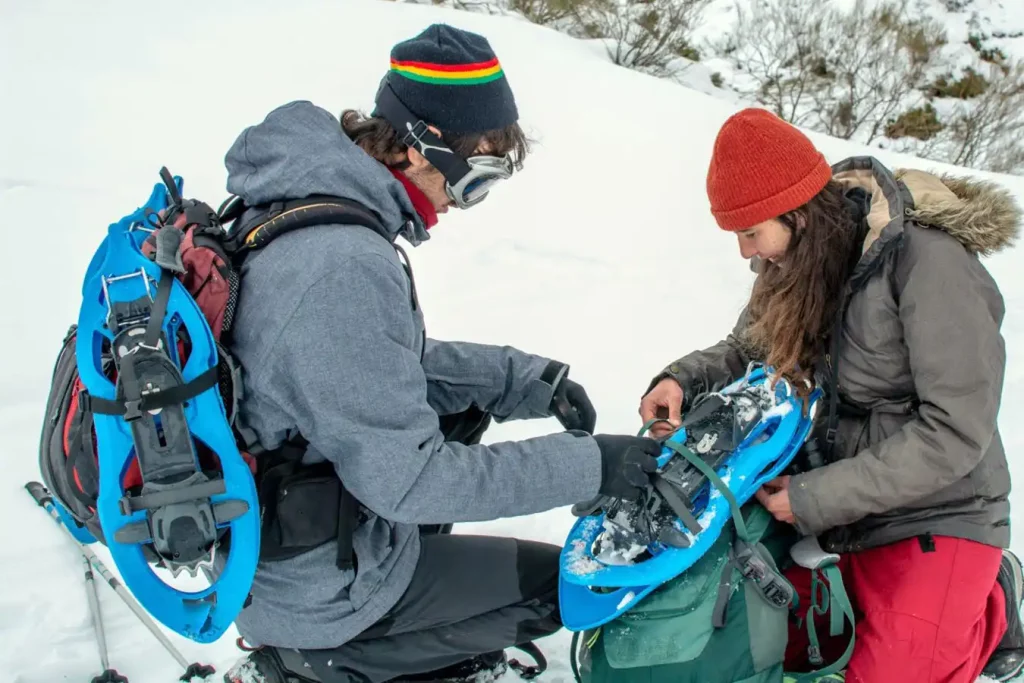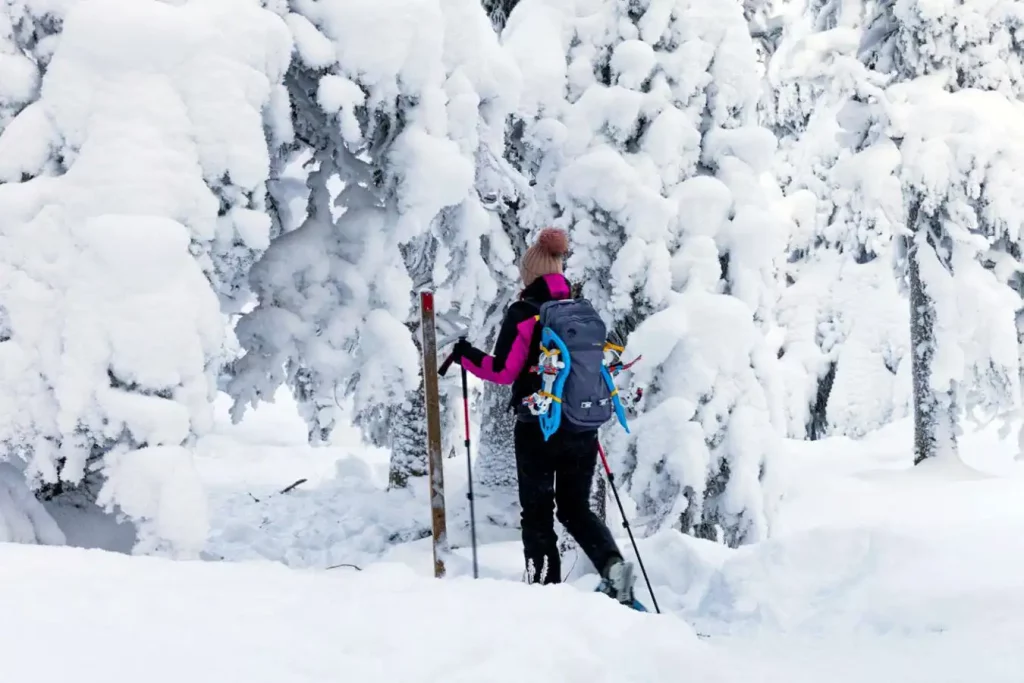Ever scratched your head, wondering how to attach snowshoes to a backpack?
I’ve been there, fumbling around, trying to figure it out.
Here’s the scoop: attaching snowshoes doesn’t have to feel like solving a jigsaw puzzle.
With a few tricks up your sleeve, you can hit the snowy trails without any awkward baggage.
Stick with me, and we’ll unpack this together!
Ready to become the envy of your fellow hikers?
Understanding Snowshoes and Their Role in Winter Exploration
When the ground is blanketed with snow, you’d think it’s time to stay indoors and warm, right? Well, not for the passionate outdoor explorer. Snowshoes become a critical tool in your arsenal, helping you traverse snowy landscapes with relative ease. But first, let’s dive a little deeper into what snowshoes are and why they’re important for winter exploration.
Brief History and Importance of Snowshoes
It might surprise you to know that snowshoes have been a trusted companion to winter explorers for thousands of years. Originally designed by indigenous communities to aid in hunting and travel during snowy conditions, these contraptions spread the weight of the wearer across a larger surface area to prevent sinking into the snow – a concept known as ‘flotation’. From these early forms, snowshoes have evolved into the diverse range we see today, all aimed at keeping you above the snow and on the move!
Various Types of Snowshoes and Their Specific Uses
Snowshoes aren’t a one-size-fits-all solution. They come in different types, each designed to perform best under specific conditions. The three main types are recreational, backcountry, and running snowshoes.
- Recreational Snowshoes are designed for easy walking on flat to rolling terrain, making them the perfect choice for beginners and casual hikers.
- Backcountry Snowshoes are the rugged, go-anywhere type. These are built for steep and icy terrain, featuring aggressive crampons and bindings for superior grip and support.
- Running Snowshoes, as the name suggests, are for those who prefer a brisk pace in their winter activities. They’re typically smaller, lighter, and designed for agility over flat or rolling terrain.
Understanding the kind of snowshoe you have is key to knowing how best to attach them to your backpack. As a tip, remember that the type of snowshoe you choose should be determined by how and where you plan to use them. Now that you’re well-versed in the world of snowshoes, you’re one step closer to tackling the great white outdoors like a pro!
Why Attaching Snowshoes to a Backpack is Important
You might be asking yourself, “Why should I attach my snowshoes to my backpack? Can’t I just wear them?” While wearing your snowshoes is fine when you’re in the midst of deep snow, there are multiple reasons why you might need to attach them to your backpack during your journey. Let’s delve into a few.
Convenience of Carrying Snowshoes on Backpack
Simply put, it’s not always snowy. On a long winter hike, you may come across segments of your trail where the snow cover is light or non-existent. Walking on such terrain with snowshoes can be awkward, tiresome, and even damaging to your snowshoes. Having them conveniently attached to your backpack allows you to easily switch between your regular hiking boots and snowshoes, ensuring a more comfortable and efficient hiking experience.
Safety and Preparedness Aspects
Emergencies and unexpected situations are part and parcel of outdoor adventures. You might come across unexpected deep snow or sudden weather changes that make navigating without snowshoes challenging or downright dangerous. Having your snowshoes within easy reach on your backpack prepares you for such situations, enhancing your safety and readiness on the trail.
Preparing Your Backpack and Snowshoes for Attachment
Before we start with the actual attachment process, we need to ensure both our backpack and snowshoes are ready for it. This involves selecting the right backpack for the task and preparing your snowshoes for attachment.
Selecting the Right Backpack for Snowshoeing
The type of backpack you choose can make a significant difference. When it comes to snowshoeing, you’ll want a backpack with external attachment points, often in the form of loops, straps, or daisy chains. These features allow you to secure your snowshoes safely. Also, consider a backpack made from durable, water-resistant material to withstand snowy conditions. Lastly, comfort is key, so choose a backpack with padded straps and good weight distribution to help you on your trek.
Cleaning and Preparing Your Snowshoes for Attachment
Before attaching your snowshoes, make sure they’re clean and dry. Snow or ice clinging onto your snowshoes might melt and soak into your backpack, potentially damaging its contents. Brush off any excess snow or ice and give your snowshoes a quick wipe down. Additionally, ensure your snowshoes’ bindings and crampons are in good condition, as these elements will play a part in the attachment process.
With your backpack and snowshoes properly prepared, you’re now set for the main event. In the next section, we’ll walk you through a step-by-step guide on how to attach those snowshoes to your backpack.
Read more: How to Attach Water Bottle to Backpack
Step-By-Step Guide on How to Attach Snowshoes to a Backpack
Now that you understand the whys and the preparations, let’s move to the hows. We’ll explain how to locate the attachment points on your backpack, discuss different attachment methods, and then present a step-by-step guide to secure those snowshoes onto your backpack.

Locating Attachment Points on Your Backpack
Typically, hiking backpacks are designed with utility in mind, and one of these utilities is the ability to carry gear externally. Look for loops, straps, or daisy chains on the outside of your backpack. These are your attachment points. Some backpacks even come with specialized snowshoe straps. Identify these points as they are where your snowshoes will be anchored.
Various Methods of Attachment and When to Use Them
Depending on the type of your backpack and snowshoes, there can be several ways to attach your gear:
- Vertical Attachment: This method involves attaching the snowshoes straight up and down on the back of your backpack. It’s a good method when you’re on a narrow trail where a horizontal attachment might snag on trees or rocks.
- Horizontal Attachment: Here, the snowshoes are attached in a horizontal manner, typically across the top or middle of the backpack. It’s preferable when the trail is wide and the risk of snagging is low.
- A-Frame Attachment: In this approach, the snowshoes are attached on either side of the backpack in an A-formation. It offers great weight balance and is useful when you’re carrying a lot of gear and need optimal weight distribution.
Choose the method that best fits your trail conditions, backpack, and personal preference.
Step-By-Step Instructions on Attaching Snowshoes to Backpack
Now, let’s go through the general steps to attach your snowshoes. We will use the vertical attachment method as an example, but the steps will be similar for other methods:
- Position the Snowshoes: Place your snowshoes side by side with their bottoms facing each other. Align them so that their bindings are at the same level.
- Prepare the Straps: Thread your straps through the attachment points on your backpack. If your backpack has snowshoe-specific straps, use those. Otherwise, any sturdy, adjustable strap should work.
- Attach the Snowshoes: Thread the straps over and under each snowshoe, making sure to secure them through the bindings or crampons for extra stability.
- Secure the Straps: Tighten the straps until the snowshoes are firmly attached to the backpack. Make sure they’re not loose or have room to move around.
- Check Your Work: Give your backpack a gentle shake to ensure your snowshoes are secure. Check the straps for any wear or damage.
In short, to attach snowshoes to a backpack, securely fasten them using the pack’s external straps or attach them to the loops or daisy chains present, ensuring the sharp points face away from the pack to prevent any damage.
That’s it! Your snowshoes are now safely attached to your backpack, and you’re ready to conquer the winter trail. Just remember, your safety is paramount, so always double-check your gear before heading out on your adventure.
Read more: How to Attach Trekking Pole to Backpack
Tips and Tricks for Securing Snowshoes
Even if you’ve followed our guide to the letter, there are a few more tips and tricks you should know to ensure your snowshoes stay secure, especially when dealing with rugged terrains.
Ensuring Secure Attachment for Rugged Terrains
For those venturing into uneven or steep terrain, security becomes even more critical. In these situations, the A-frame method is often the most secure because it distributes the weight evenly across your pack, making it less likely to shift as you move. It’s also a good idea to double-check the tension in your straps every time you stop for a break. Cold temperatures can affect the elasticity of straps, causing them to loosen over time.
How to Prevent Damage to Your Backpack and Snowshoes
Prevention is the best cure, as they say. To avoid damage to your backpack, make sure that your snowshoes’ sharp points, like the crampons, aren’t in direct contact with the backpack material. You can use a piece of durable cloth or foam between them. For your snowshoes, avoid over-tightening the straps as it could warp them out of shape.
Caring for Your Backpack and Snowshoes Post-Attachment
After a day of winter exploration, your gear will need a bit of TLC. Let’s see how to clean and store your snowshoes and maintain the integrity of your backpack’s attachment points.
How to Clean and Store Snowshoes After Use
After use, remove any snow or ice from your snowshoes and allow them to air dry, away from direct heat. Once dry, check for any damage or signs of wear. When storing, hang them in a cool, dry place, away from direct sunlight which could deteriorate the materials over time.
Maintaining the Integrity of Your Backpack’s Attachment Points
Regularly check your backpack’s attachment points for any signs of fraying or damage. If you notice any, repair them promptly to avoid further damage. Keep the points clean from dust and dirt, and consider applying a protective spray to shield them from the elements, extending their lifespan.
FAQs about Attach Snowshoes to a Backpack
How do you attach snowshoes to a small backpack?
How do you carry snow shoes on a backpack?
How do you attach snowshoes to a hiking backpack?
How do you attach snowshoes?
Conclusion
Attaching snowshoes to a backpack may initially seem like a daunting task, but with a bit of knowledge and practice, it becomes second nature. Remember, the goal is not just convenience, but also safety and preparedness for any situation that might arise on the trail.
So now, you’re all geared up, ready to traverse those beautiful, snow-filled landscapes with your snowshoes securely attached to your backpack. Go out there, explore, and make the most of your winter adventure – but remember to do it safely. Happy snowshoeing!
To know more: What Size Snowshoes Do You Need


